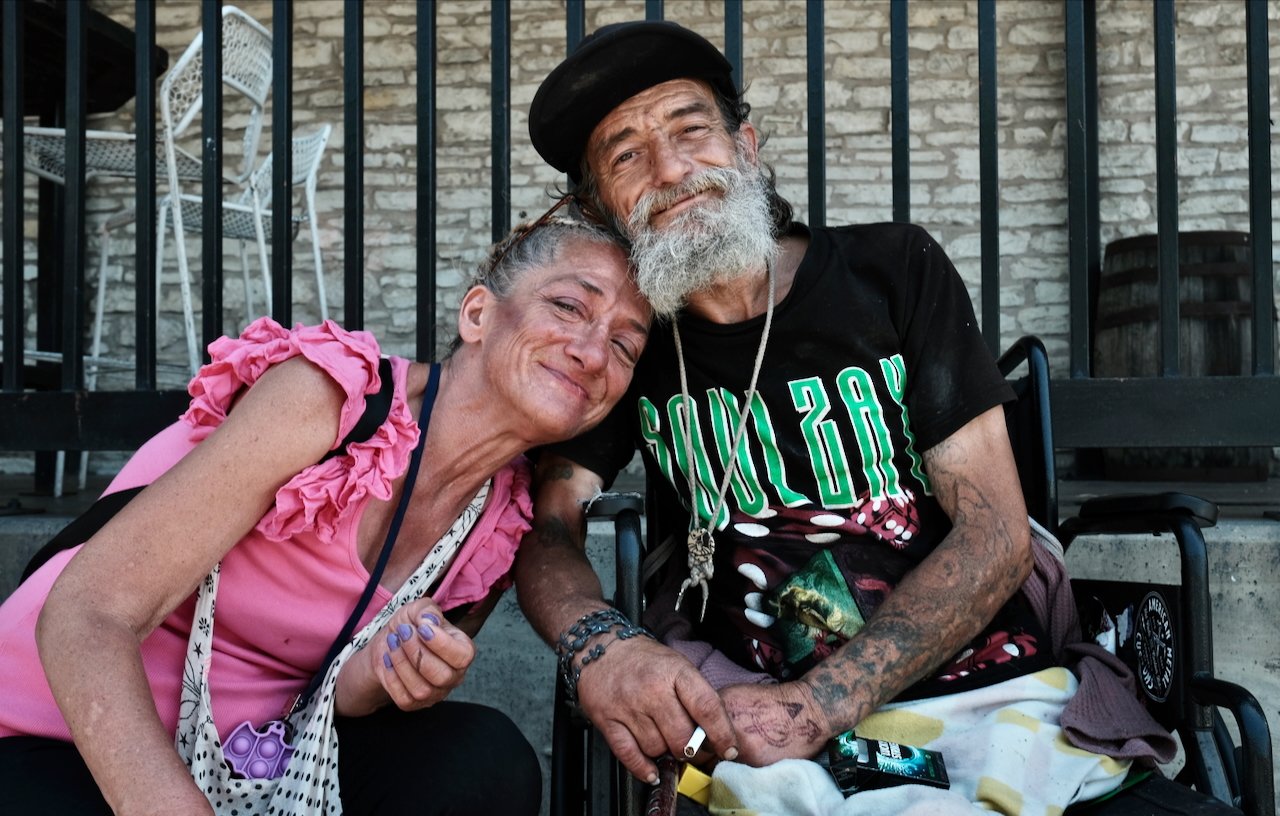Photojournalist Camille Wheeler with friends Cat Fako, left, and Hobbit Fowler on Sixth Street in downtown Austin during the COVID-19 pandemic in spring 2020.
My favorite place to take photos is on Sixth Street in downtown Austin, Texas. I have photographed protests and marches and such events as the Día de los Muertos parade, the SXSW Music Festival, and the Republic of Texas Biker Rally and the Pecan Street Festival, both of which sadly are now gone.
During the worst months of the COVID-19 pandemic in 2020, I documented the shuttering of bars and other businesses that turned Sixth Street into a ghost town.
But most important to me is my relationship with the unhoused community on Sixth and throughout downtown. Since launching an exploration of that community in early 2016, I have established many friendships, some for life, I am sure, with people experiencing homelessness.
Friends Lisa Lanier and Cody Cottrell on Sixth Street.
If you’ve met someone who’s homeless, you’ve met someone who’s homeless. As I have learned, there are myriad reasons for why some individuals wind up living in their cars, in tents, and on the streets. These reasons include: the sudden loss of a job, unaffordable housing, the traumatic loss of a child or parent, post-traumatic stress disorder, disabilities, illness, racial disparities, domestic and sexual abuse, estrangement from family members, jail and prison time, addiction, and the financial inability to secure health insurance and medical care for a raft of issues.
Essentially, I am documenting the juxtaposition of community and poverty. But my work is not from a distance. My project started haltingly. I was timid about approaching folks and was trying to come into my own as a photographer after spending a quarter century in the newspaper and magazine industry as a writer and editor. But eventually, I discovered a simple truth: In general, people wanted to talk. They wanted to be seen, they wanted to be heard, they wanted conversation and the opportunity to tell their life stories. They wanted to look others in the eye and not have those individuals turn away in disgust or fear.
Perhaps most surprising, I continue to find that people want to be photographed. They want to be documented, as if seeking proof for themselves and for others that they exist. Those familiar with me on Sixth know that I’m a fan of the close-up portrait. Camera lens held close to a subject’s eyes for maximum emotional depth of field.
Richard and Teresa in an Austin hospital on the last day of her life.
Over the past several years, I’ve become much more involved in the lives of my unhoused friends. In 2022, I lost a dear friend, Teresa, to esophageal cancer. She and her partner, Richard, alternately lived in their tent and in a van, and a few times, I rescued them on the upper deck of never-safe Interstate 35 when they ran out of gas. Richard and I were with Teresa when she smoked her last cigarette outside of a hospital. Later that day, she died in Richard’s arms in her hospital bed.
In 2023, another close friend of mine, Trey, was severely burned and underwent multiple surgeries on his lower left arm and hand. Today, thanks in large part to the positive hospital and rehabilitation care he received, he is off the street and back home with his wife and family.
Last year, my friend Cody suffered frostbite on his toes during a prolonged freeze. Already confined to a wheelchair because of a painful bone disease called avascular necrosis, he had several surgeries and ultimately lost his legs to amputation. Cody is still living on Sixth Street, where he is a longtime resident.
I have lost friends to heat stroke and gunshot wounds. I carry Narcon because I have witnessed overdoses. But all in all, I will say this from my front-row seat: The Sixth Street community of bars and establishments and owners, general managers, restauranters, bartenders, door guys, musicians, artists, comics, tourists, pedicab drivers, security guards, emergency responders, and members of the unhoused population are just that: a community.
It is my honor to photograph this community. With that said, I have made it my mission over the past couple of years to create a historical photographic record of historic East Sixth Street between Congress Avenue and Interstate 35 before, during, and after the city’s most storied thoroughfare experiences significant redevelopment change. Stay tuned for more photos and updates.




